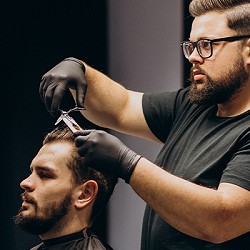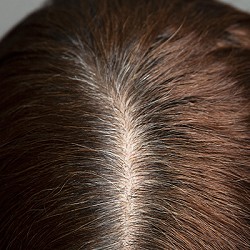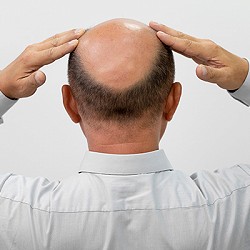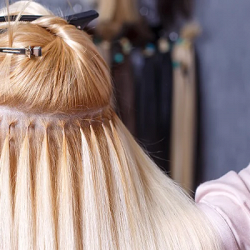
ADVANCED HAIR STUDIO
10 Causes of Hair Loss and Baldness in Men
- 10 October 2022
- 4 min. read
Alopecia, or hair loss, can be either temporary or permanent and affect your scalp or the entire body. It could be brought on by hereditary characteristics, hormonal changes, diseases, or a typical aspect of ageing. Even though everyone can, men are more likely than women to lose hair on their heads.
The word “baldness” frequently refers to dramatic scalp hair loss. A very common reason for baldness is hereditary hair loss as people age. Some people prefer not to use hair treatments or camouflage to stop their hair loss from occurring naturally. Some people may conceal it by wearing hats, scarves, makeup, or hairstyles. Others decide to use therapy to either stop additional hair loss or encourage growth.
Before beginning any programme, consult an expert about the possible causes and solutions for your hair loss treatment.
Also Read : Pattern Baldness Hair Regrowth
Causes of Hair Loss in Men
A person typically loses 50–100 hairs per day. It frequently goes unnoticed because new hair is growing at the same time. In the case of baldness, when new hair grows, the hair that has fallen out is not replaced. Hair loss is brought on by one or more of the following factors:
- Male Pattern Baldness (Androgenetic Alopecia) Male pattern baldness is among the most common factors of male hair loss. This illness, also known as androgenetic alopecia, may start to affect you in your 20s or 30s. Over 50% of men face some level of affliction by the age of 49. You will typically notice your hairline beginning to recede and look elder if you are prone to male pattern baldness. Vertex baldness, a type of hair loss that affects some males, is the beginning of hair loss around the vertex or crown of the head. Genetic factors and your body’s production of androgens, or male sex hormones, can collectively be responsible for male pattern baldness.
- Family Background (Heredity). The most familiar cause of hair loss is a hereditary condition that worsens with age. Men often have a receding hairline and bald spots, while women typically experience thinning hair at the top of the Head. Typically, it happens gradually and in predictable patterns. This condition is AKA androgenic alopecia, male-pattern baldness, or female-pattern baldness.
- Medical issues and Hormonal Shifts Numerous conditions, including hormonal changes caused by pregnancy, delivery, menopause, and thyroid problems, can lead to permanent or temporary hair loss. Medical conditions include ringworm infections of the scalp, immune system-related alopecia areata, and the compulsive hair-pulling disorder trichotillomania are a few examples.
- Head-focused Radiation Treatment It may be possible that the hair won’t regrow the same way due to a Head focused radiation hair treatment. Scarring may result in permanent hair loss.
- Shock or Tension Hair loss that could endure for several months can be caused by sudden weight loss, severe physical or emotional stress, surgery, or even fever and the flu.
- Infections Things like ringworm can cause bald spots and scaly areas on the scalp. After treatment, the hair generally grows back.
- Immune System You might have alopecia areata, a genetic illness, if you experience sudden hair loss that produces circular, quarter-sized bald spots all over your Head. Often, it starts in early life. If a close relative has it, you are also more likely to have it.
- Grooming Traction alopecia, also known as transient hair loss, can occur when the hair near the scalp is pulled wearing a ponytail, braids, or cornrows. Perms and hot oil treatments may also harm your hair follicles.
- Bad Diet Even if dietary problems don’t result in permanent hair loss, telogen effluvium can be exacerbated by certain nutritional deficits. For instance, inadequate protein intake and anemia contribute to transient hair loss.
- Age Most people have hair loss as they become older because hair growth slows. Hair follicles eventually stop producing new hair, thinning hair on our scalp. The color of the hair also starts to fade. The hairline of a woman normally begins to recede.
Also Read : Androgenetic Alopecia In Men And Women
Also Read : A Better Way to Counter the Hereditary Hair Loss
Small patches of hair emerge as your body’s immune system attacks the hair follicles. There is no discomfort or illness involved, and it is not spreadable. Your hair might regrow, but it might also start to fall out again.
However, some people who receive treatment early can regrow their hair.
Treatments Available for Hair Loss

Multiple hair treatments are available at AHS Clinic to treat any case of Hair loss. The client can visit the AHS Clinic for an Advanced Hair Check to understand the cause behind the hair loss and get the treatment accordingly. Some of the treatments offered by AHS Clinic include:
- Advanced Laser Therapy
- Strand by Strand Ultimate
- Strand by Strand Cosmetic
- Home Programme
- AHS Complete
No matter if your hair loss is from family history, stress, hormonal changes, or any other issues. AHS Clinic has hair fall treatment for all hair fall issues, and we promise 100% desired results with our treatments.
Conclusion
AHS Clinic has mastered hair regrowth treatment with path-breaking technology and a team of wonderfully experienced surgeons and consultants who will help you get the desired results in no time. If you want your confidence and full Head of natural-looking hair back, then book an appointment now with an AHS Expert.
-
Rate this post:
- - 121votes
Our Google Reviews






Related Posts
August 26, 2024
Mastering the Craft: The Path to Professional...
India's beauty and wellness sector has grown significantly, creating opportunities for exceptional people to...
August 22, 2024
How is the Immune System Related to Hair Growth
The human body is an intricately integrated system operating in unison. The correlation between the immune system...
August 14, 2024
Do Wigs Cause Hair Loss - Busting the Myths
For both men and women, hair loss can be an unpleasant experience. It can impact our self-esteem and confidence,...
August 07, 2024
Reasons Why You Should Go for Permanent Hair...
Since hair extensions are an excellent way to increase your hair's length, volume, and colour, they have grown in...










